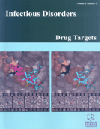-
s Modulation of Host Cell Nucleocytoplasmic Trafficking During Picornavirus Infection
- Source: Infectious Disorders - Drug Targets (Formerly Current Drug Targets - Infectious Disorders), Volume 12, Issue 1, Feb 2012, p. 59 - 67
-
- 01 Feb 2012
Abstract
Picornavirus infection is characterised by host cell shutoff, wherein host transcription and translation processes are severely impaired. Picornavirus proteins interact with host cell proteins, resulting in alterations in the host cell synthetic, signalling and secretory machinery, and facilitating transcription and translation of viral proteins to achieve increased virus replication and assembly. Among the many cellular pathways affected, recent studies have shown that disruption of nucleocytoplasmic trafficking via inhibition of the functions of the nuclear pore may be a common means of picornavirus- induced pathogenesis. Disruption of nuclear pore functions results in nuclear proteins being relocalised to the cytoplasm and reduced export of RNA, and may be a mechanism by which picornaviruses evade host cell defences such as interferon signalling, by blocking signal transduction across the nuclear membrane. However, the mechanisms used and the viral proteins responsible differ between different genera and even between viruses in the same genus. This review aims to summarise current understanding of the mechanisms used by picornaviruses to disrupt host cell nucleocytoplasmic trafficking.


